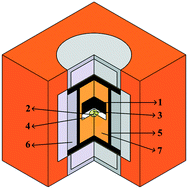Study on the crack phenomenon of heavy FeS-doped Ib diamond crystals with {111} surface as growth surface in Fe–Ni–C system
Abstract
Herein, the characteristics of heavy FeS-doped diamond crystals were studied using a China-type large volume cubic high-pressure apparatus (CHPA) with FeNi alloy as the catalyst at 6.0–6.5 GPa and 1350–1400 °C. The crystals were characterized via optical microscopy (OM), scanning electron microscopy (SEM), X-ray photoelectron spectroscopy (XPS), Fourier transform infrared spectroscopy (FTIR) and Raman spectroscopy (Raman). OM of the crystal showed that the crystals cracked when the doping ratio was increased, and an increase in pressure was beneficial to alleviate the phenomenon of cracking. The XPS spectrum of the crystal showed that S successfully enters the diamond lattice in three bonding modes, C–SO2–C6H5, C–S–SO2–C and C–S, under high concentration doping conditions. The infrared spectrum showed that the content of N in the crystal decreased with an increase in the doping ratio. The Raman spectroscopy analysis showed that the heavy FeS-doped Ib-type diamond single crystal has a high quality sp3 structure, and the full width at half maximum (FWHM) of the crystal gradually broadened as the doping ratio increased. Additionally, it showed that increasing the pressure under the same doping concentration is beneficial to increase the crystallinity of the crystal.



 Please wait while we load your content...
Please wait while we load your content...